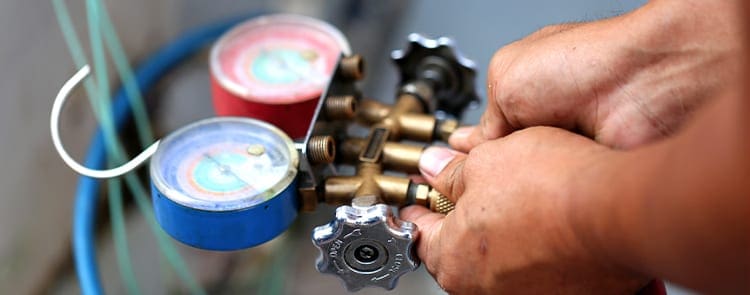Blogs
What is a Refrigerant?
11/6/2015

Refrigerants are used in every cooling device we own. Refrigerators, freezers, cars, and home air conditioners all use a refrigerant to control temperature. But did you know that a refrigerant can also be used to heat a home? An air conditioner works by moving heat out of the home, conveying heat from a cold area to a warm area. A reversible heat pump switches this process around to pump heat from outside into the home to warm it. So what is a refrigerant? What is running through that thin coil behind your freezer that releases so much heat?
Basics
Refrigerants are made up of many different substances, but they are usually fluids and typically undergo a phase transition (where the fluid switches from liquid to a gas and vice versa). A few exceptions to this do exist. Air refrigerants do not change state but undergo extreme compression to act as a refrigerant. It’s not as efficient but is still an effective method of heat transmission.
Back in the 20th century, the most common refrigerants were fluorocarbons and chlorofluorocarbons. While they make exceptional refrigerants, both of these substances are hazardous to humans, plants, and deplete the ozone layer. Replacements such as ammonia, carbon dioxide, and non-halogenated hydrocarbons hold a promising future for safe refrigeration that is non-toxic.
Ideal refrigerants have the best thermodynamic properties. This is the refrigerant’s ability to absorb and release heat when undergoing a phase change. Refrigerants must also be nonflammable, nontoxic, and non-damaging to the ozone layer. At present, each possible refrigerant has some degree of danger. Even air compression refrigerants pose a risk of combustion if oil leaks into the compression chamber.
Heat Pumps and Air Conditioners
We’ve already covered how an air conditioner works, well a heat pump does the same thing in reverse. By switching the location of the evaporator and the condenser, the heat pump works to cool the outside air. Really it reduces the temperature of the refrigerant in an attempt to make it colder than the outside air, where it is warmed by outside air until it boils into a gas. A compressor increases the pressure of this gas until it’s warmer than the temperature inside the home. At this point, the gas hits the condenser where it sheds heat into the surrounding atmosphere, warming the home.
Since a refrigerant needs to be capable of gaining heat from cold environments, it needs to be extremely susceptible to phase changes or be capable of high compression ratios. As time progresses, we find safer refrigerants with better thermodynamic ranges.
Alternatives
Heating a home is simply a matter of bringing a hotter object into the room. From there, thermodynamics takes over and temperatures try to equalize between the room and the heated object. This is why fluids are such a beautiful medium for transferring heat. Running a heated gas or liquid into a room means a constant supply of new heat. Traditional examples for this are forced air furnaces, which heat air and then force it into a room where it warms the room, and radiators, which heat water and push it through a series of pipes where the heat from the water radiates out and warms the room.
In short, refrigerants are used for exchanging heat from a cold area to a warmer one. By creating a substance that’s cooler than the surrounding air, it can absorb the heat and release it in a warmer room. Refrigeration is an amazing technology that not only keeps things cool during the summer but warm during the winter as well!
Service Legends Heating and Cooling has a team of experts who know everything there is to know about refrigerants and to use them for heating or cooling!
Thank you for making Service Legends the #1 provider of residential heating and air conditioning in the Des Moines area. A live and friendly customer care representative is ready to take your call 24/7 at 515-COMFORT (515.266.3678).
515-657-6634Request Appointment Online
Return- January 2024
- October 2023
- September 2023
- August 2023
- January 2023
- December 2022
- November 2022
- October 2022
- September 2022
- August 2022
- July 2022
- June 2022
- May 2022
- April 2022
- March 2022
- February 2022
- January 2022
- May 2021
- November 2020
- October 2020
- September 2020
- July 2020
- June 2020
- May 2020
- March 2020
- February 2020
- December 2019
- November 2019
- September 2019
- May 2019
- April 2019
- January 2019
- December 2018
- November 2018
- October 2018
- July 2018
- October 2016
- September 2016
- August 2016
- July 2016
- June 2016
- May 2016
- April 2016
- March 2016
- February 2016
- January 2016
- December 2015
- November 2015
- October 2015
- September 2015
- August 2015
- July 2015
- June 2015
- May 2015
- April 2015
- March 2015
- February 2015
- January 2015
- December 2014
- November 2014
- October 2014
- September 2014
- August 2014
- July 2014
- May 2014
- March 2014
- February 2014
- January 2014
- December 2013
- November 2013
- October 2013
- September 2013